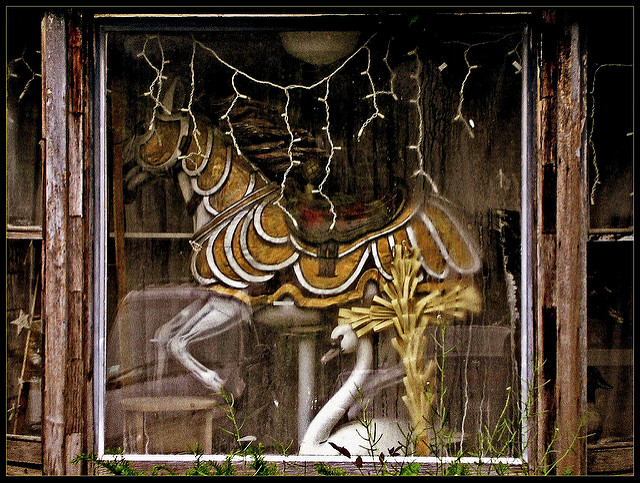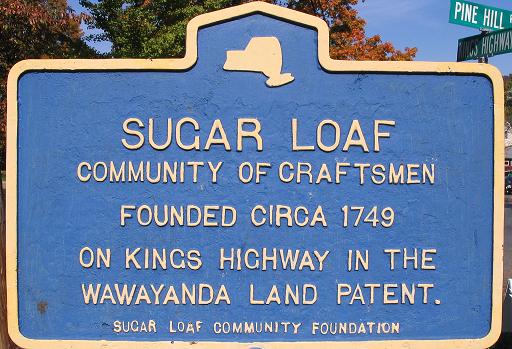
ONE ARTISAN VILLAGE
I think that in every Maker’s heart of hearts, there is a dream of being surrounded by others like them who live their lives working and dancing to their own heartsong, trying to do their own best work and cheering each other on to greater effort.
We dream of a place that supports us in our journey while letting us find our own way to our own best life.
AN ARTISAN DREAM
One of the oldest established “artisan communities” in America is the village of Sugar Loaf, which is a small hamlet roughly six miles long and five miles wide, in the town of Chester in New York’s Orange County. It’s been around since the 18th century.
The village was originally a waypoint along the King’s Highway, providing supplies and horses for the travelers along that road. It was a busy place and went through many changes as the world moved through and then past it.
Back then it was likely that every tradesperson was some sort of artisan, if the definition of “artisan” is someone who makes things by hand. (There wasn’t any other way to make useful things.)
Sometime around the middle of the last century, the village had become little more than a forgotten bit of the landscape between crowded metropolises. Transportation routes had changed and it was no longer a hub and hive of activity.
There gathered a group of artists and artisans who took up residence in Sugar Loaf and began doing their work in the old falling-down buildings and barns that had endured for a couple of hundred years. These Makers found a place with room enough and time enough to do the work they loved.
In the course of things, a core group of these full-time working craftspeople opened up their independent artist’s studios to the public, selling the works of their hands to support lives they found meaningful.

(I have to warn you: Bob is a bit cantankerous.)
As Fugett points out, some of the early artisans continued to develop their skills in their chosen work to a high level.
Over the years other Makers joined in as the earliest of these creative people and their neighbors made a community that was centered around producing locally made, one-of-a-kind, high quality creative work.
The people who appreciated the quality of the work they produced came in droves from all over the world.
THE CHANGES DO KEEP ON COMING
But, the Way of the Creative is never an easy road. In his musings on his website, Fugett mourns the lost shape of the community he helped to build.

“It’s my experience that artist communities are almost always camps because they appropriate space that nobody else wants (at the time), but by virtue of a creative progressive view of neighborhoods they create a demand from others that ultimately marginalizes them, so they are forever transient.”
It’s a pithy commentary on what happens after the Makers have made Beauty in some abandoned place, which then becomes a “destination,” and then gets made over into something else as other folks move in.
This YouTube video, “Artists and Artisans,” was published in 2017 by Sarah J. Burns. It’s a mini-documentary featuring interviews with some of the artisans currently living in the village and focuses on how their livelihoods changed with the recession. It also offers a glimpse of the village itself.
FINAL THOUGHTS
The future is never certain, but the village continues anyway and it will grow into some new shape that better reflects the Makers who now live and work there in these very different times.
One of Bob’s salty comments that is spot-on nevertheless is this: “Talent is bullshit; work is the thing, and of course it is all for naught, always has been, always will be, but that has nothing to do with the doing of it.”
Here’s a poem:
CHANGE
That things will change is a given
There is no argument.
Established constructs will be riven
And much will fade of past efforts spent.
Still and yet and ever more
The world keeps turning in its place.
Still and yet, there will be joy,
There will be rainbows and always grace.
Change comes, change goes
And so do you and I.
The only things we get to keep
Are the ways we walk and fly….
by Netta Kanoho
Header picture credit: “The Work Never Matches the Dream….” By Kendra via Flickr [CC BY-NC 2.0]
……
SOME OTHER POSTS TO EXPLORE:
(Click on each of the post titles below and see where it takes you…)
……
Thanks for your visit. I’d appreciate it if you’d drop a note or comment below and share your thoughts.
21 thoughts on “ONE ARTISAN VILLAGE”
Hello and thank you for the article.
This certainly raises the level of articles written here as it deal with something that is more than just making money.
I didn’t know about this artisan village and thank you for the information. been in Orange county many times but never knew about this village.
The poem about change is very capturing and provides a reflection about the meaning of life.
Thanks again,
Eli
Hey Eli:
Thanks for visiting and for sharing your thoughts. I do appreciate it.
Please do come again….
Wow, Sugar Loaf sounds like a great village and definitely one that AnxietyPanda would love to have been a part of, had she been closer.
Thank you also for the mini-documentary that provides a look at what it’s like in Sugar Loaf! The village has now made my bucket list of places to visit before I die 🙂
Hey AnxietyPanda:
Thanks for the visit to my site. I am glad you enjoyed it!
Please do come again….
Actually, I don’t believe I said that (all of it)… at least I don’t specifically remember it and couldn’t find it with quoted Google search. Too bad the Burns effort was diverted by some itenerate passers-through and failed to show the true artists still living and working here.
Sorry, found the quote exactly as you reported it using a local search on my own files.
It was part of a response to a comment by potter Connie Rose.
Once again sorry, and great website by the way.
Thanks for checking on that, Bob. I’m glad I got it right! (Hee!)
Please do come again….
Great! I love the simplicity at which you write, Your blog design (village structure) also looks good. So much insight in one article, and as Eli said, it’s more than just making.
I’m currently undergoing some tutorials on how to make a leather bag, and I think it’s best for me if I stick to this village.
Thanks for the visit and your comments, faftop. I do appreciate it.
Please do come again….
To be sincere I have never came across a place or village called sugar loaf community of crafting. This article has brought the knowledge of places we thought could never have existed and still in existence. Craft work and other areas have been looked down upon over the years. Thanks for posting this.
Thanks for your visit and for sharing your thoughts, Olalekan. I have noticed that when a society’s focus is on the future and on getting to a more modern way of living, it is often a side-effect that the traditional crafts and ways of thinking are discounted, looked down on and even actively discouraged.
However, I have also noticed that the grandchildren and those who come after the forward-looking generation of a people, the ones who have grown up in a more modern version of their society and culture often feel the need to connect back to their roots in order to find out who they really are.
As a Hawaiian, I grew up not knowing how to speak my native language because it was actively discouraged. The crafts and arts, the music and dance that sustained our way of life was almost lost entirely. This has changed tremendously in my own lifetime.
It all came back. It is all growing and developing in new and wonderful ways.
And this “renaissance” and “revival” all began because a few people kept to the old ways and then their grandchildren came back wanting to know more about who and what they came from and they brought their friends along with them.
I am glad you enjoyed the post. Please do come again….
Thank you for this great post.
I’m actually a fan of artisan communities but am saddened by how few there really are. Add to that the inevitable changes that come as other, non-artists, move into the charming communities and, by their very non-artist nature, change the community into something else and you can see these communities becoming a dying breed.
I guess that’s the way of things, build something people admire only to have them try to enter the community and change it.
I wish more artist communities would pop up. Sadly, I think the cycle would just repeat itself. There are online communities but it’s just not the same.
Thanks again,
Scott
Scott, thanks for your visit and for sharing your thoughts.
You’re probably right….it’s the cycle: artists discover some out-of-the-way place that is affordable and allows them to do their dream and they make beauty. Admirers come and come and come and then the artists get pushed out because they can no longer afford being there. So, they go find someplace else…or not. (Sigh!)
But, maybe that’s part of the whole “artist” deal. It’s an artist’s function, after all, to see the hidden beauty and reveal it to the world. The world then beats its way to the artist’s door and all those uncaring feet trample things and the uncaring minds rearrange stuff for their own comfort until it all starts looking like every place else again.
It happens.
But, for real, for the artist in the time of the cultivating and nurturing and growing of the beauty, it really is not a bad way to live, I say.
Please do come again.
Hi, Netta.
Thanks for sharing the information on Artisan village – the lost diamond in the concrete jungle.
I was surprised by the comment of legend Bob Fugett himself. Though he forgot his quote it is a pure reflection of that era and the changing time.
I would love to visit this small village in my present lifetime. So emotional.
Warm Regards,
Gaurav Gaur
Garav, thanks for your visit and for sharing your thoughts. I did love it that Bob Fugett chimed in. I’m pleased you enjoyed the post.
Please do come again.
The idea of this kind of community is fascinating!
I wonder if we have any similar villages or towns here in the UK.
There are plenty of maker spaces online and (before COVID) events but I think if I were creative I’d prefer to live in one of these communities.
A bunch of artists and makers grouped together like this really appeals to me, but only now I’ve read your article!
Keep up the good work!
Tony
Thanks for your visit and for sharing your thoughts, Tony. From what I’ve seen, artisans, musicians (and makers of all sorts) tend to congregate and create their own communities in neighborhoods in cities and around the countryside that have seen and lived through some sort of economic downturn or that is no longer fashionable or where the rich people no longer want to hang.
They look for the places that are not so rough that there is constant warfare. They look for the aging, dilapidated places and places that are run-down.
Rents are not so expensive there. The neighborhoods may be a bit chancy but for a certain sort of person, that might actually be a stimulating sort of place to make their life.
They search for groups of creatives who have already begun to make some sort of a go at living in these kinds of places. (If you’re hooked into the network of creatives who live in these places, then it’s likely you’ll be able to find a support group of friends.)
Some people say that artists and other outlier-creative sorts are like the canaries miners take with them into mines. When the birds stop singing and fall over dead, the miners know there’s invisible, odorless poison gas in a passageway.
These Makers are sort of like those birds. What happens is these outliers and outsiders find places in cities and around the country side where the neighborhoods have been abandoned by “polite” society and make their places among the other outsiders who have congregated there.
In the course of things, they attract the attention of the money-people, who then want to live around these exciting un-boring people. They buy up the properties. Rents get expensive. The new guys move in. The Makers move away (unless they happen to be successful enough in their craft to be able to stay).
The Makers are the canaries that rediscover or unveil the beauty of a place and enhance and transmute the ugly into something else. In this way, the place gets rejuvenated and then it comes to the attention of the ones who like that sort of thing.
These others may not be the kind of Creatives who are into the arts and music and performing. Perhaps what they make is more lucrative for them.
In any case, they have money and they buy up the beauty the outsiders have made….and the ones who have breathed new life into the old abandoned places either move off or die if they cannot adapt to mundanes cluttering up the landscape.
Repeat, repeat, repeat…ad infinitum.
I assume this happens in every country. I tend to think it is also the price you pay if you’re wanting to be a not-so-civilized sort, but maybe that’s just me and my own biases.
I am glad you enjoyed the post.
Please do come again.
Mass-produced products just don’t have the same “heart” as handmade products.
You know, It’s not just the quality of handmade products. That can be imitated. For example, a defining trait of handmade carpets is that handmade carpets will have imperfections in them. They will never be perfectly symmetrical. The gaps between the threads WILL vary.
So what ended up happening is that the machines were adjusted to replicate these imperfection. What they couldn’t imitate, however, were the passion and love for the craft.
Thanks for your visit and for sharing your thoughts, hfs01. You are absolutely right, I think.
Please do come again.
Great article. Sugar Loaf sounds like an amazing village. I also love the fact that you provided the history of the town, very interesting. I like history and reading about it. I would love to visit Sugar Loaf one day.
I also like the layout of your sight. It is easy to navigate and you have some great illustrations. Thank you for a great article.
Thanks for your visit and for sharing your thoughts, Paul. I do appreciate it.
Please do come again.